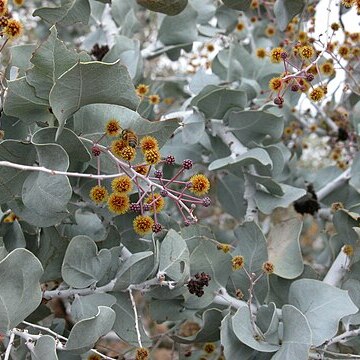Somewhat gnarled glabrous tree 2–4 m tall, sometimes to 8 m. Bark thick, corky. Branchlets normally pruinose. Stipules spinose, sometimes only bases persisting. Phyllodes inequilaterally ovate to elliptic or obovate, sometimes ±obliquely orbicular, normally 2–5 cm long and 1.5–3.5 cm wide, variably undulate, normally acute to acuminate, pungent, coriaceous, normally grey-green, glabrous; midrib prominent and excentric; lateral nerves forming a close, normally prominent reticulum. Inflorescences terminal or axillary racemes; raceme axes 5–18 cm long and (together with the peduncles) purple-red and often pruinose; peduncles mostly twinned and 1–2 cm long; heads globular, c. 30-flowered, golden; buds dark purple-red. Flowers 5-merous; sepals free, sometimes shortly united. Pods curved to openly 1½-coiled, to 11 cm long, 7–10 mm wide, firmly chartaceous to thinly coriaceous, pruinose. Seeds longitudinal, oblong to ±orbicular, 4.5–6 mm long, dull, brown, ±encircled by funicle.
More
A small prickly shrub. The trunk is twisted and gnarled and the bark is thick and corky. The branches are spiny. This means the shrub is very prickly. The leaves (phyllodes) are 2-4.5 cm long by 2-3 cm wide. They are thick and rigid and covered with a bluish bloom. The leaves have unequal sides and are sail shaped. They have a sharp point at the end. The flower buds are purple. The flower heads are golden balls. Often they have a darker orange brown centre. There are many flowers and they are produced in the angles of leaves in stalked flower clusters. The pods are 6-8 cm long by 0.8-1 cm wide. They are curved almost in half circles. They are covered with a bluish bloom.
Tall, open shrubland with spinifex ground cover, growing on stony plains and hills, in sand or sandy loam, basaltic and alkaline soils.
More
It grows in arid areas. It suits hot dry climates. It needs a well drained soil and a sunny position.
Grows in sand or sandy loam, often on rocky hills, in tall shrubland with spinifex ground cover.


